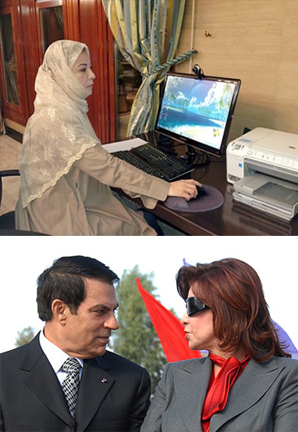
top, Leila Trabelsi in Saudi Arabia; bottom, Leila Trabelsi with Ben Ali in Tunis, pre-Jasmine Revolution
The West has long had a fascination with Muslim women, from the Oriental harem beauties of Ottoman seraglios to immigrants who wear niqab in Europe. As some critics have noted, perhaps those who laud or victimize the role of women in Islam (as though there could be “the” role), should look at the patriarchy in their own societies. The ability to go out in public with less of the body covered may be a sign of freedom in mobility, but it is not automatically symbolic of equality in economic or political terms. Ethnographic study for almost a century has illustrated the kinds of social contexts in which women and men are closer to being egalitarian, but there is no one factor (including religion) that is causal. The books and commentaries on women in Islam continue to proliferate and will into the foreseeable future. But what about the situation today within Islamic countries?
By today, I mean the totally unscientific sense of an arbitrary internet experience. In checking out several websites this morning to see what I might comment upon, several items caught my attention. First, a Yemeni website shows a photograph of Leila Trabelsi, the wife of the exiled Tunisian president Ben Ali; both are now living in Saudi Arabia (top picture, above). The picture is pregnant with interpretive possibilities. The former elegant first lady is now regaled in hijab while mouse-clicking her way through cyberspace. In that vast digital archive, she can easily come across previous pictures of herself, like the one shown below her new Saudi makeover look. So is one of these pictures of Leila more Islamic than the other? Does the veil indicate intent; does living in Saudi Arabia signify a closer relationship to Allah? Perhaps if we knew what websites she was surfing, we would have more clues. Continue reading What (who) drives Muslim women

